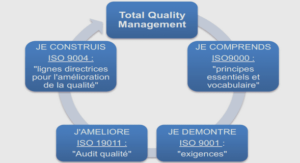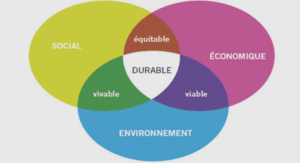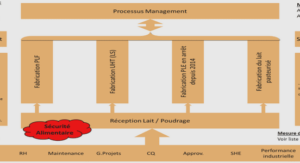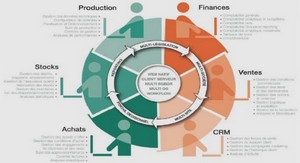Historical background to marketing
According to LAMBIN (2000), the word ‘’marketing’’ originates from the United States of America and its genesis can be summarized in several periods, including:
◆ The data period 1945 where the supply was lower than the demand.
◆ The data period 19501 where the supply was average on the demand.
◆ The data period 1956 where the supply was greater than the demand.
The latter period marks the beginning of a competitive market with certain forms of advertising, since it is the marketing of a service that is bound to the products. These are intangible assets.
Definition of Marketing
According to the Dictionnaire Larousse usuel, the term marketing originates from the English word ‘’market ‘’ which means the place where they sell several things, and the suffix. “-ing” which implies the notion of movement. According to KOTLER and DUBOIS (1994), marketing is the economic and social mechanism by which individuals and groups meet their needs and desires through the creation and exchange of products and other entities of value for others.
Marketing Objective
The aim of marketing is to achieve the sale of a product in the best conditions, consumer satisfaction and profitability for the company. Indeed, any company seeks to obtain the most reliable information to create the product market and satisfy the consumer or the customer so as to maintain confidence. In order to obtain the information that can allow to direct the actions of the company in the most effective way possible, the marketing proposes a methodology of the commercial decision gathering techniques of information processing and analysis, to ensure the development of a profitable business activity based on market knowledge, which allows us to approach the marketing plan.
Marketing Task
The most common image of the head of marketing is that of a man who is in charge of stimulating demand for the company’s products. However, this concept is too limited to take into account the different tasks it assumes. Marketing management consists of planning and implementing the development, pricing, promotion and distribution of a product or service with a view to a mutual exchange satisfactory to both organisations and individuals.
Marketing Tools
Three tools exist for the exercise of the marketing activity:
➤ Market research: it consists of organizing to know the target market
➤ Market segmentation and targeting; it consists of adopting things to the market
➤ The “4p” policy of operating in the target market.
Marketing in launching a product
During the launch phase, marketing is necessary to inform consumers, encourage them to try the product, and ensure its distribution to merchants. It takes a lot of money to convince and stimulate distribution. There are several types of marketing in their applications about launching a product in the company and it depends on the object that the managers have assigned themselves. These include:
Innovation Marketing
This type of marketing is based on all the operations to be carried out as a process of planning, analysing, executing and controlling of a programme, the outcome of which would be the realization of the mutual profile due to an exchange. This marketing is applied in the study of the sales market, total product quality, number of customers and their distribution.
Marketing planning
Its purpose is to plan the business activities of the company, defining the policies and strategies that can ensure its optimal growth.
Audit Marketing
It focuses on the overall assessment of the performance of the marketing organization within a commercial reproduction unit and their performance; turnover, profitability, economic return, etc.
Functional Marketing
The function of goods consists in its expanded capacity to satisfy the needs of the consumer. Therefore, this type of marketing applies to products whose complementarity meets the desire of the user or the consumer. After a cursory passage on the type of marketing used on the launch of a product, we can do an overview on other kinds of marketing.
Types of Marketing
Commercial Marketing
Commercial Marketing is about creating an incentive for future consumers to buy a product.
Social marketing
Every time, it requires to obtain, after a well-conducted awareness, a change of behaviour, attitude of everyone for the benefit of the community. For example The HIV/AIDS Campaign.
Political Marketing
It is the act of promoting the ideas of a candidate close to an electorate by creating a difference compared to other candidates. It is therefore a global image of main ideas.
Marketing Approaches
The fundamental message of the marketing concept is that the economic performance of the company depends essentially on its ability to efficiently meet the needs of the market and to redeploy its activities according to the changing needs and opportunities offered by the technology. Therefore, various methods allow marketing to achieve its objectives. There are two types of marketing:
➤ Strategic Marketing
➤ Operational Marketing .
Strategic Marketing
It defines the main orientations of a company and seeks attractive market opportunities. Indeed, the company first seeks to know the needs of the market and the behaviour of potential buyers or consumers. This allows it to define the markets it wants to compete with. This reference market must be divided into a homogeneous sub-set in terms of the needs and buying motivation called potential market product. For each of its market products, the analysis of diversities, needs, and the evaluation of economic opportunity and the analysis of their probable lifespan will be carried out. It is on the basis of these sets of information that the company will be able to appreciate the attractiveness of these various market products.
Operational marketing
Operational marketing, also known as marketing mix, aims at conquering the market using the well-adapted controllable action variables. Certainly, the marketing demand supports the analysis of customer needs. This analysis leads to the understanding of the conceptual framework for strategic marketing. The strategic directions chosen must be implemented through operational marketing. The latter is a decisive factor in the company’s performance, particularly in the market where competition is intensive. Indeed, any product of high quality must have a price acceptable to the market and be adapted to the shopping habits of the customers to be supported by advertising activities designed to publicize its existence and promote its distinctive qualities. Operational marketing is therefore the business arm of the company. The variations that constitute the essence of the latter’s activities are: the ‘’4p’’. Product policy, price policy, distribution policy and communication policy.
GENERAL INTRODUCTION |




